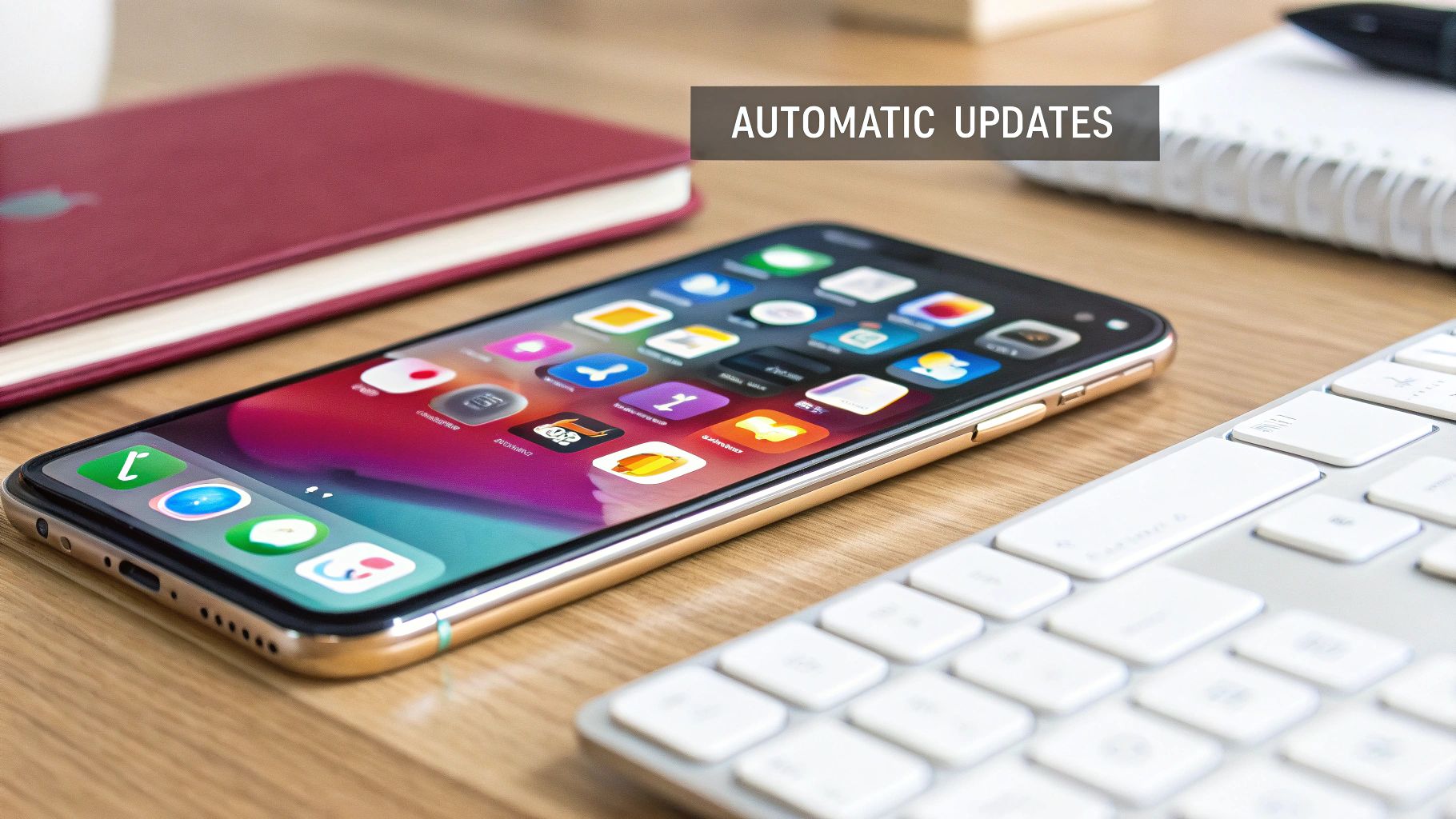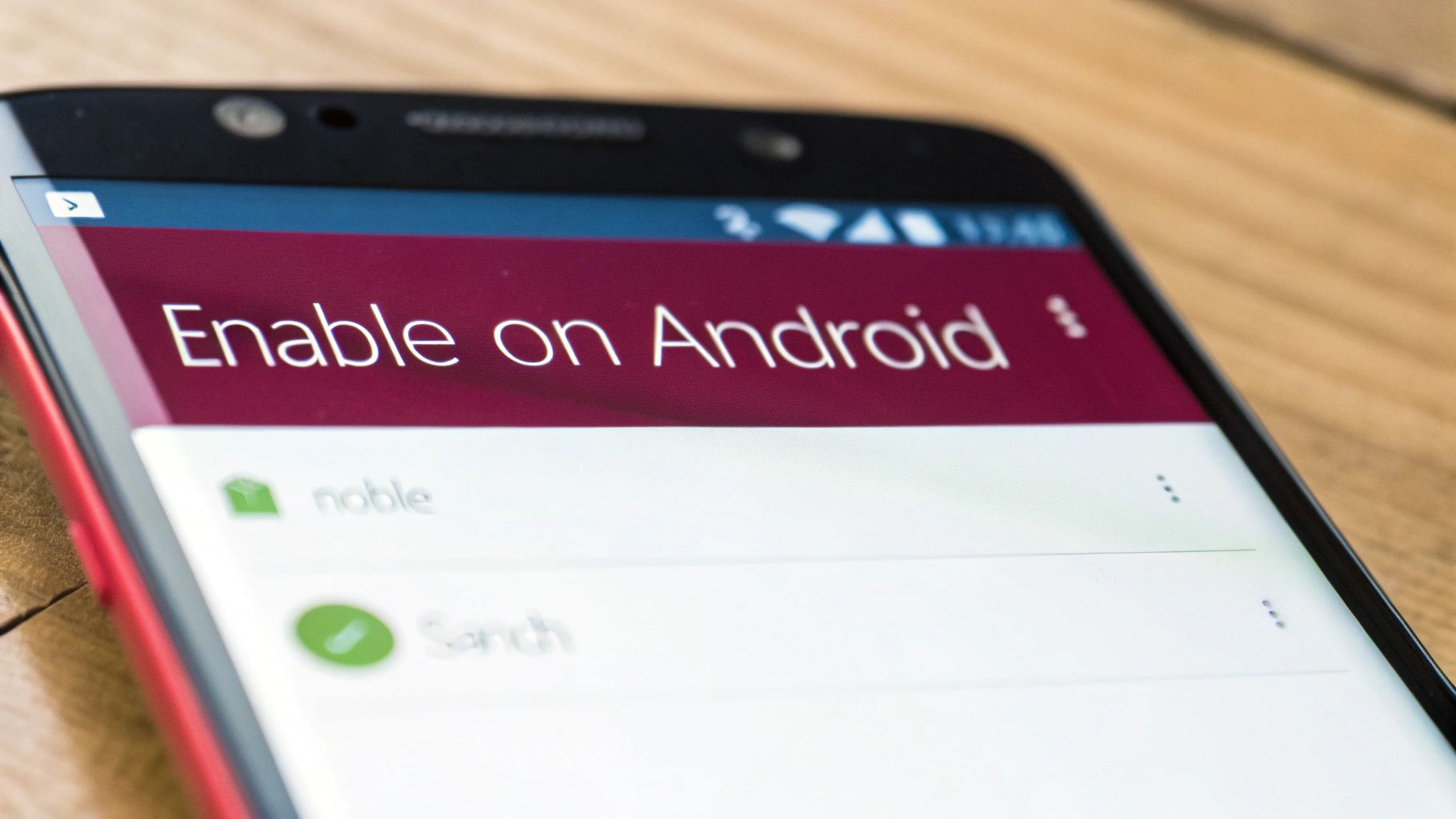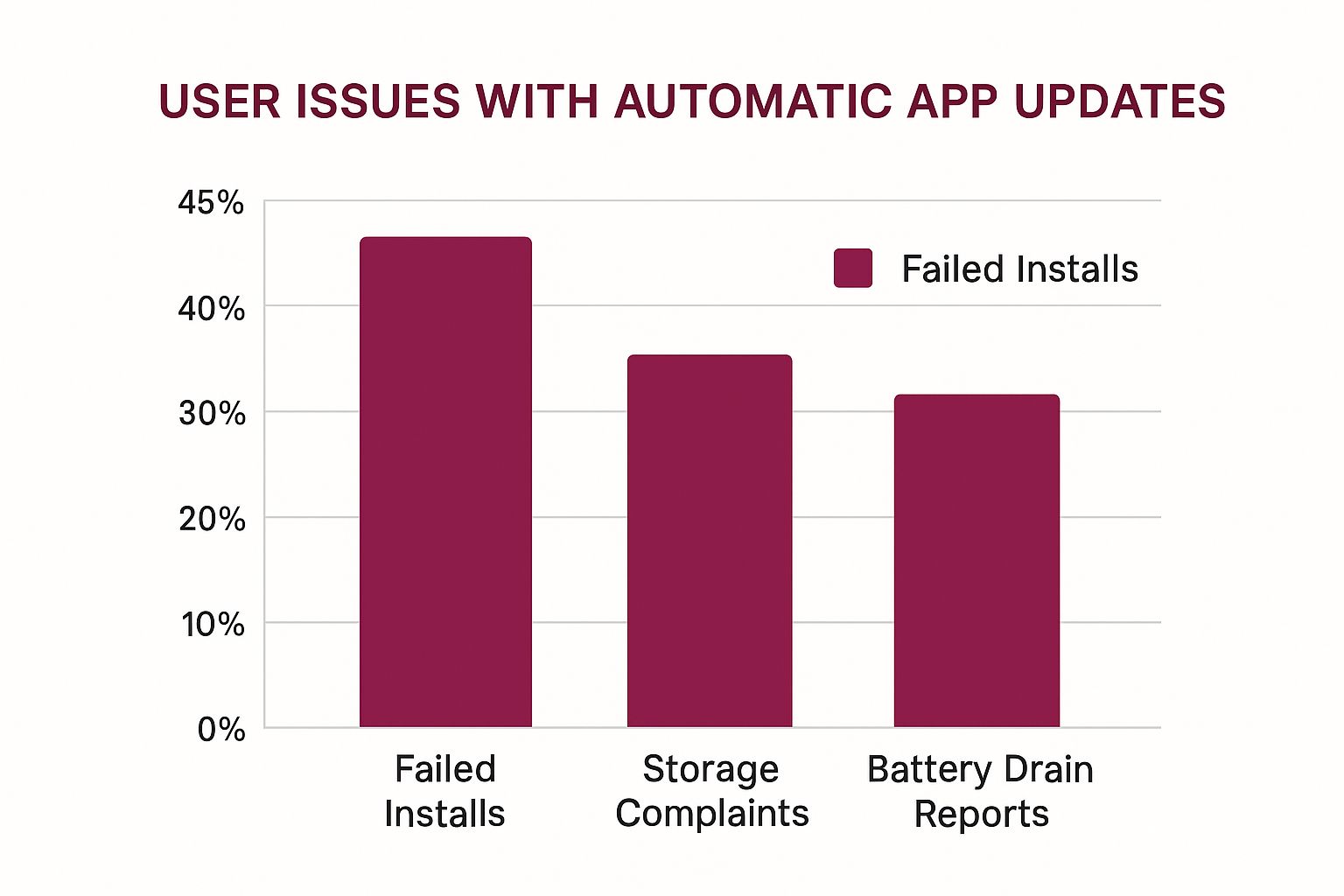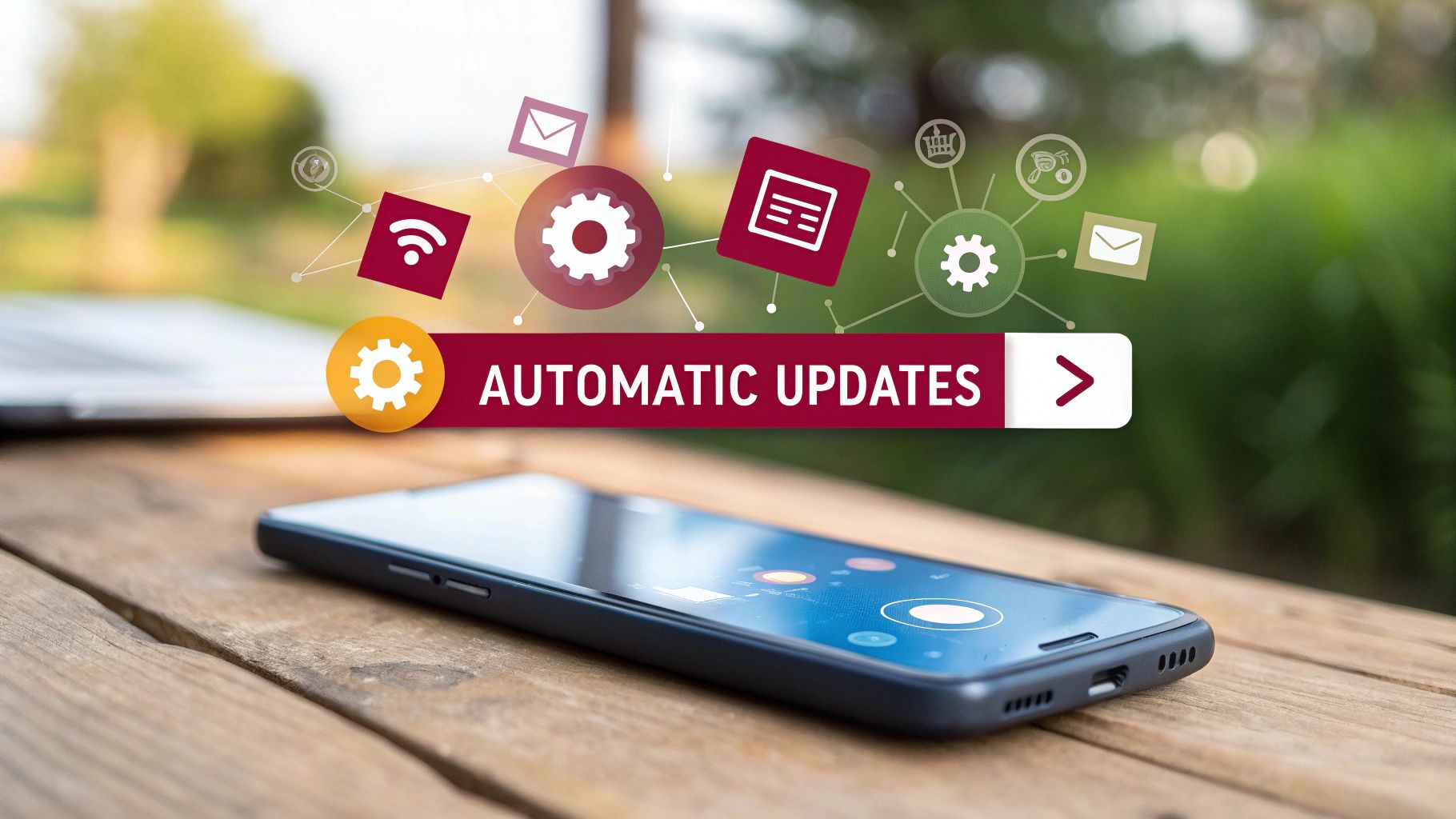The Evolution of Automatic App Updates: Benefits Beyond The Obvious

Automatic app updates have become a fundamental aspect of modern software development. They’ve evolved from a simple convenience feature to a critical component of a successful app strategy. This shift highlights the widespread recognition of the interconnected benefits that automatic updates offer, going far beyond just fixing bugs. These benefits include strengthened security, improved user experiences, and more efficient development workflows.
Enhanced Security and User Experience
A primary reason for the growing importance of automatic updates is the constantly increasing demand for better security. Outdated apps with known vulnerabilities are attractive targets for cyberattacks. Automatic updates provide an essential defense by rapidly deploying security patches. This minimizes the time users are exposed to these vulnerabilities.
Automatic updates also greatly improve the user experience. Users gain access to the newest features and performance enhancements without the hassle of manual downloads and installations. This seamless process leads to higher user satisfaction and engagement.
Application updates frequently enhance existing systems. For a more detailed understanding of these improvements, see Compresto 1 12 Updates Enhancements Fixes And New Features. This demonstrates how regular updates build a more reliable and feature-rich user experience. This continuous improvement process also helps boost app store ratings and encourages positive user reviews.
Furthermore, the frequency of these updates has increased significantly, reflecting the fast-paced app development landscape. By January 2025, about 23% of apps on the Apple App Store were updated weekly. This number rose to 34% by April 2025, indicating a notable jump in update frequency. This trend emphasizes developers’ commitment to providing timely improvements and maintaining a competitive advantage. You can find more detailed statistics here: Apple App Store App Updates by Frequency.
Streamlined Development and Competitive Advantage
Besides the direct benefits for users, automatic updates significantly improve development workflows. Developers can quickly fix bugs and introduce new features without depending on users to manually update their apps. This speeds up the development cycle, allowing for more flexible responses to user feedback.
This increased agility provides a significant competitive edge. Companies that can rapidly iterate and improve their apps are better equipped to meet changing user needs and stay ahead of the competition. This proactive approach to app maintenance contributes to increased market share and sustained success in the competitive app market. The ability to continuously adapt and improve is now a requirement for success in the mobile-centric world.
Strengthening Your Digital Fortress Through Automatic App Updates

Security is paramount in our interconnected world. Automatic app updates are essential for a robust digital defense. These updates do more than just introduce new features; they protect users from evolving threats by patching vulnerabilities and neutralizing exploits, ensuring a secure user experience.
The Importance of Timely Updates
Timely updates are the first line of defense against emerging threats. Think of your apps as the walls of a fortress. Cracks and weaknesses inevitably appear. Automatic updates are like the masons, constantly repairing these breaches before attackers can exploit them. This proactive approach minimizes the window of vulnerability, keeping data and systems safe.
Zero-day exploits, vulnerabilities unknown to developers, pose a significant threat. Automatic updates offer a crucial mechanism for rapidly deploying patches as soon as they are available. This neutralizes exploits before they can cause significant damage. This rapid response is essential for maintaining a strong security posture.
Addressing Security Gaps and Communicating With Users
Update fragmentation, where different users run different app versions, creates dangerous security gaps. Automatic updates ensure everyone uses the most secure version. This uniformity strengthens the overall security of the user base. However, communicating these security fixes requires a careful, transparent approach.
Clearly explaining the nature of security updates without technical jargon helps users understand their importance. This builds trust and encourages acceptance of automatic updates, allowing users to appreciate their value and contribute to a safer digital environment.
To understand the impact of automatic updates on various vulnerabilities, let’s look at the following table. It showcases how these updates mitigate common security risks.
Introducing the table “Security Vulnerabilities Addressed Through Automatic Updates”, this table compares the risks of outdated apps with regularly updated applications.
| Vulnerability Type | Risk in Outdated Apps | Protection Through Auto-Updates | Notable Examples |
|---|---|---|---|
| Zero-Day Exploits | High risk of data breaches and system compromise due to unknown vulnerabilities. | Rapid deployment of patches as soon as they are available, minimizing the window of vulnerability. | Numerous data breaches targeting outdated software. |
| Malware Infections | Increased susceptibility to malware infections due to unpatched security flaws. | Updates include patches for known vulnerabilities, reducing the risk of malware infiltration. | Various malware campaigns exploiting known software vulnerabilities. |
| Data Breaches | Outdated apps are easier targets for hackers seeking to steal sensitive data. | Security updates strengthen data protection measures, reducing the risk of data breaches. | Large-scale data breaches involving outdated systems. |
| System Instability | Unpatched vulnerabilities can lead to system crashes and instability. | Updates address stability issues, ensuring smooth and reliable app performance. | System crashes and performance issues due to outdated software. |
This table clearly demonstrates the importance of automatic updates in mitigating several types of security vulnerabilities. By automatically patching these flaws, we significantly reduce the risks associated with outdated apps.
Real-World Examples and Case Studies
Real-world security breaches highlight the consequences of relying on manual updates. Many companies have suffered significant data breaches due to outdated software. Automatic updates, by ensuring timely patching, could have prevented many of these incidents. This demonstrates the real-world impact and necessity of implementing automatic updates.
Examining how automatic update systems effectively neutralize zero-day exploits is critical. Services like CodePushGo offer the ability to instantly deploy updates, helping protect apps against these emergent threats and minimizing potential damage. This proactive security approach is key.
If your users aren’t on the latest version, they are vulnerable. Automatic app updates are no longer a nice-to-have but a necessity for maintaining a secure digital fortress. They are an essential investment in protecting user data and maintaining the integrity of your app ecosystem.
Building Bulletproof Automatic Update Systems: Technical Mastery

Creating a reliable and robust automatic update system for your app is a complex process. It demands a thorough understanding of various technical aspects, going beyond simple implementation and diving deep into the architecture and strategies behind truly effective systems. This guide will empower your team to build automatic update systems that are both scalable and user-friendly.
Choosing the Right Update Mechanism
The foundation of a successful automatic update system lies in selecting the right update mechanism. Different architectures come with their own set of advantages and disadvantages. Here are some key options to consider:
-
In-App Updates: These offer developers granular control over the update process, enabling a customized user experience. However, they require more development effort.
-
Store-Facilitated Updates: This approach utilizes the existing infrastructure of app stores, such as the Apple App Store and Google Play Store, for simplified distribution. The trade-off is that these updates are subject to store approval processes, which can introduce delays.
-
Server-Driven Updates: Server-driven updates provide maximum flexibility and control over update rollout and timing. This approach enables A/B testing and staged rollouts, allowing developers to gather valuable user data. Tools like CodePushGo offer instant, background deployments, eliminating the delays often associated with traditional app store updates.
The best mechanism for your application depends on your specific needs and priorities.
Optimizing for Bandwidth and User Experience
Efficient bandwidth usage is crucial, particularly for mobile applications. Delta updates offer a significant advantage by downloading only the changed portions of the app. This reduces download size, minimizing user data consumption and speeding up the update process.
Background downloading is another important consideration. By allowing updates to download in the background, you ensure a seamless user experience without interrupting their current activity. This targeted approach saves time and resources.
Ensuring Update Integrity and Preventing Corruption
Verifying update integrity is paramount to prevent corrupted downloads from causing problems. Techniques like checksum comparisons confirm that downloaded files match the intended version. This safeguard is essential for avoiding crashes and maintaining app stability.
Robust dependency management is also critical. This ensures that all necessary components are updated correctly, preventing conflicts and maintaining compatibility. This keeps all parts of your app working together seamlessly.
Implementing Staged Rollouts and Monitoring
Staged rollouts are a crucial safety net. By releasing updates to a small subset of users initially, you can identify and address critical issues before they impact a wider audience. This acts as a valuable test run, allowing for early detection and resolution of unexpected problems.
Comprehensive monitoring tools offer detailed insights into update success metrics, including download completion rates and error reports. This data informs continuous improvement of the automatic update system, guiding future development and refinements to deliver a high-quality update experience for all users.
Crafting Update Experiences Users Actually Appreciate
The most technically proficient automatic app update system can fall short if it doesn’t resonate with users. Finding the right balance between keeping apps up-to-date and respecting user preferences is essential. Notification timing, transparency, and how permissions are requested all have a significant impact on user satisfaction.
Timing and Transparency Are Key
Think of app updates as helpful assistants, not intrusive interruptions. Ideally, updates should occur silently in the background, completing before the user even opens the app. For instance, scheduling updates during inactive periods, like overnight, minimizes disruptions. This unobtrusive approach keeps the app current without impacting user workflow.
Transparency is paramount. Users appreciate knowing what changed and why. Well-written release notes, using clear and simple language, explain the value of each update. Instead of simply listing technical fixes, highlight new features and their benefits. This approach transforms updates from a technical necessity into valuable enhancements.
Respecting User Preferences and Building Trust
Give users choices about automatic updates. Allowing them to opt in or out, or select preferred update times, empowers users and builds trust. This demonstrates respect for their time and preferences, enhancing their overall experience.
Clearly and concisely explaining the benefits of automatic updates – such as improved security and performance – within the app encourages adoption. For those implementing a robust automatic update system, understanding modern CI/CD pipelines is crucial. Further research on CI/CD pipeline best practices can provide valuable insights for a more seamless and user-friendly update experience.
Understanding User Behavior
Understanding how different user demographics respond to updates is vital. Some users eagerly adopt new features, while others prioritize stability and may hesitate to update. Tailoring communication and offering choices helps address these varying preferences.
The mobile app market continues its rapid expansion. The global market is expected to achieve 299 billion downloads by 2025, with gaming and subscription-based apps fueling much of this growth. This emphasizes the importance of regular updates to maintain quality and competitiveness. Learn more about mobile app download statistics. These statistics highlight the continuing significance of app maintenance in a dynamic market.
Designing for High Adoption Rates
By employing these evidence-based strategies, developers can create automatic update experiences that feel helpful rather than intrusive. This results in higher adoption rates, ensuring that more users benefit from the latest features and security enhancements. Ultimately, this creates a more satisfied and secure user base, strengthening the relationship between user and app. A positive user experience promotes brand loyalty and contributes to long-term app success.
Mastering Update Frequency: Finding Your Perfect Rhythm

The infographic above highlights common user issues with automatic app updates. Failed installs are the biggest problem, impacting 45% of users. Storage concerns affect 30%, while 25% report battery drain. Addressing these issues is clearly vital for user satisfaction. Developers should focus on robust updates and transparent communication.
How often should you release automatic app updates? This seemingly simple question requires a strategic, thoughtful approach. Finding the right rhythm involves balancing your app’s needs, user expectations, and development resources.
Understanding Industry Benchmarks
Update frequency varies across app categories. Mobile games, with regular content updates and events, may require weekly or bi-weekly updates. Productivity apps, however, prioritize stability and often update monthly or quarterly to minimize workflow disruption. Aligning updates with user expectations is key to satisfaction.
These are general guidelines. Your ideal frequency depends on your app’s complexity, team size, and available resources. Smaller teams handling complex apps may prefer less frequent, larger releases. Larger, well-resourced teams might adopt continuous delivery, focusing on frequent incremental changes.
To better illustrate typical update frequencies, let’s examine the following table:
Update Frequency Comparison by App Category
This table presents typical update frequencies across different app categories, highlighting industry standards and their impact on user engagement and retention.
| App Category | Typical Update Frequency | User Expectations | Benefits | Considerations |
|---|---|---|---|---|
| Mobile Games | Weekly/Bi-weekly | Frequent content and features | High engagement, quick bug fixes | Requires significant development resources |
| Productivity Tools | Monthly/Quarterly | Stability and minimal disruption | Predictable updates, reduced risk of bugs | May not address issues quickly |
| Social Media Apps | Weekly | New features and performance improvements | Enhances user experience | Requires thorough testing |
| E-commerce Apps | Bi-weekly/Monthly | Security updates and new features | Improved security and user experience | Balancing stability with new features |
| Utility Apps | Monthly/Quarterly | Bug fixes and stability | Reliable performance | Less frequent feature updates |
As this table illustrates, different app categories have varying update patterns. Mobile games favor rapid updates for new content, while utility apps focus on stability. Finding the right balance for your app category is essential.
Balancing Incremental Improvements and Feature Releases
Consider the balance between small, frequent updates and larger feature releases. Smaller updates address bugs and tweak performance, minimizing disruption. Larger updates, however, create excitement and introduce significant improvements.
The right balance depends on your users and your development process. Some users value constant improvements, while others prefer fewer, larger changes. Your team’s capacity also plays a role. CodePushGo accommodates both incremental and full updates, allowing you to tailor your strategy based on user needs.
Integrating Emergency Hotfixes
Emergencies can occur. A critical bug or vulnerability may require immediate action. Automatic app updates provide a rapid deployment mechanism for emergency hotfixes, maintaining user trust. However, frequent hotfixes suggest underlying development process issues. They are valuable but shouldn’t replace proper testing and quality assurance.
Effective planning and communication are crucial. Services like CodePushGo streamline update management, offering real-time analytics and one-click rollback for rapid responses to unforeseen issues. Developers can quickly address problems, minimizing disruptions and maintaining a positive user experience. By adopting a strategic approach and using tools like CodePushGo, you can optimize your update frequency for both users and developers.
The Future of Automatic App Updates: Innovations Reshaping Development
Automatic app updates are constantly improving. Looking ahead, we can expect exciting changes that will reshape how we handle software maintenance and updates. These changes are not just small steps forward, but fundamental shifts in how developers, apps, and users interact.
AI-Powered Personalization and Predictive Updates
Imagine updates tailored to your individual app usage. This is the promise of AI-powered update systems. By analyzing individual user interactions, AI can prioritize and schedule updates to minimize disruptions. For example, if a user primarily accesses an app during their commute, the app could schedule updates overnight. This ensures a seamless experience during peak usage.
Taking this a step further, predictive technologies could anticipate user needs. By analyzing usage data and current trends, these systems could preemptively download updates. They could even predict and address potential bugs before they become widespread problems. This proactive approach transforms automatic updates from reactive maintenance to a more anticipatory service.
Background Processing and Seamless Integration
Improvements in background processing are making updates nearly invisible to users. Updates can complete silently and efficiently without interrupting workflow. This quiet, efficient approach boosts user satisfaction and removes friction from the update process.
This seamless approach extends to how updates are delivered. Edge computing allows for more efficient distribution. By placing update servers closer to users geographically, download speeds increase and latency decreases. This enables developers to deliver critical fixes and features more effectively.
Enhanced Security and 5G Connectivity
Blockchain technology could significantly improve the security of automatic app updates. By verifying the integrity of updates through blockchain, developers can ensure updates haven’t been tampered with, protecting against malicious code. This secure delivery system builds trust with users and provides peace of mind.
The growing availability of 5G connectivity creates opportunities for richer, more frequent updates. The increased bandwidth and lower latency of 5G networks enable faster downloads of larger updates. This means developers can deliver more complex features and improvements without negatively affecting the user experience.
Evolving App Store Policies and Progressive Web Apps
App store policies are in constant flux. Developers must adapt to ensure compliance for their automatic update systems. Staying up-to-date on these changes is vital for a smooth and uninterrupted update experience for users.
Progressive web apps (PWAs) are also impacting traditional update models. PWAs, being web-based, update themselves without requiring any user interaction. This seamless experience sets a new standard, encouraging developers to improve native app updates to provide the same level of convenience.
The Challenge of Augmented Reality
Augmented reality (AR) applications pose unique challenges for automatic updates. The complex software and its reliance on hardware require careful update strategies. Developers must ensure updates don’t disrupt existing AR experiences or cause compatibility problems with various devices. This emerging field requires creative solutions for smooth and efficient automatic updates.
The future of automatic app updates is promising. These innovations are set to create a smoother, more secure, and personalized experience for users. At the same time, they will give developers better tools and strategies for managing the update process.
Ready for the next generation of automatic app updates? CodePushGo offers instant, background deployments, real-time analytics, and one-click rollback capabilities. Empower your development team to streamline updates and enhance user satisfaction.
Article created using Outrank




